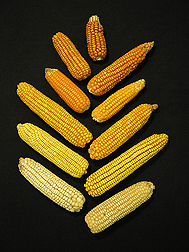Boosting Vitamin A Levels
in Corn To Fight Hunger
Corn is essential to the diets of hundreds of millions of people in developing countries, including those in sub-Saharan Africa. But millions of those people are at increased risk of health problems because their corn-based diets lack enough vitamin A. Some 40 million children are afflicted with xerophthalmia, an eye disease that can cause blindness, and 250 million people suffer health problems because of a lack of dietary vitamin A. Agricultural Research Service researchers and colleagues at Purdue University and the International Maize and Wheat Improvement Center (CIMMYT) have made some discoveries that could change that.
Corn contains carotenoids, such as beta-carotene, that our bodies convert to vitamin A, but only a very small percentage of corn varieties have naturally high carotenoid levels. Using genetic and statistical tools, the researchers have identified two genes in corn that are linked to higher beta-carotene levels, and they have developed a cheaper and faster way to screen corn plants for more genes that will produce even higher levels of the essential nutrient. The research is expected to at least triple the levels of carotenoids in Africa’s corn and could increase levels in some varieties far beyond that, according to Edward Buckler, a geneticist in ARS’s Robert W. Holley Center for Agriculture and Health in Ithaca, New York.
The project, funded in part by the National Science Foundation, included major contributions from geneticist Marilyn Warburton of the ARS Corn Host Plant Resistance Research Unit in Starkville, Mississippi; Torbert Rocheford, a crop geneticist at Purdue University in West Lafayette, Indiana; and Jianbing Yan, from CIMMYT in Mexico.
Corn is one of the world’s most genetically diverse food crops. Like people, each ear has a slightly different genetic makeup, resulting in slightly different characteristics. That poses a formidable challenge to scientists trying to understand the genetic basis for any corn nutrient. Direct nutrient-screening techniques are expensive. A common technique, high-performance liquid chromatography, can assess levels of beta-carotene in individual plant lines, but screening a single sample costs $50 to $75. Breeders need to screen hundreds—or more—of plants at a time, making the cost prohibitive. Genetic screening via molecular markers would be a more efficient option for screening large numbers of plants if genes involved in high beta-carotene levels were known. After identification of high-carotenoid corn lines, markers enable efficient transfer of the trait to many new varieties via marker-assisted selection; this is important because farmers in developing nations need high-carotenoid varieties that will grow over a wide range of climates and conditions.
A New Approach and a Better Way To Assay Corn
The team took a new approach to identify specific genes and regions of the corn chromosomes that influence production of carotenoids. They examined the corn genome through “association mapping,” a method made possible by recent breakthroughs in statistical analysis and DNA sequencing, techniques that accelerate genetic profiling of crops. Association mapping taps the natural genetic diversity of corn to find new and useful traits.
In their study, the researchers surveyed the genetic sequences of diverse corn from around the world. They found two naturally mutated genes, each producing an enzyme at lower levels than those found in most corn varieties. Plants with either gene mutation have higher levels of beta-carotene, and plants with both mutations have higher levels still. Identification of the two genes using the new methods was an important breakthrough in nutritional plant breeding and has been published in the journals Science (2008) and Nature Genetics (2010).
After genes are identified via association mapping, markers can be developed from these genes to allow for marker-assisted selection, which is much simpler, faster, and “up to 1,000-fold cheaper” than running the types of chemical tests previously used, Buckler says.
Now, scientists in developing countries can cross the newly identified high beta-carotene lines with local varieties and, applying the markers developed from these two genes, choose progeny that are adapted to local growing conditions but still retain high beta-carotene.
Warburton, Yan, and Michael Gore, a former graduate student in Buckler’s lab who is now an ARS geneticist at the U.S. Arid-Land Agricultural Research Center in Maricopa, Arizona, are working with various international organizations, such as CIMMYT, China Agriculture University, and the International Institute for Tropical Agriculture, to train plant breeders in developing countries to use their techniques. Some African maize has as little as 0.1 micrograms of beta-carotene per gram of corn. The researchers are confident they will eventually find genes that result in corn with 15 micrograms of beta-carotene per gram, a target for nutritional scientists around the globe working to improve corn varieties and fight world hunger.
“We see large variation in the corn genome, and that gives us a lot to work with,” Warburton says.—By Dennis O'Brien, Agricultural Research Service Information Staff.
This research is part of Plant Genetic Resources, Genomics, and Genetic Improvement, an ARS national program (#301) described at www.nps.ars.usda.gov.
To reach scientists mentioned in this article, contact Dennis O’Brien, USDA-ARS Information Staff, 5601 Sunnyside Ave., Beltsville, MD 20705-5129; (301) 504-1624.
"Boosting Vitamin A Levels in Corn To Fight Hunger" was published in the May/June 2010 issue of Agricultural Research magazine.







